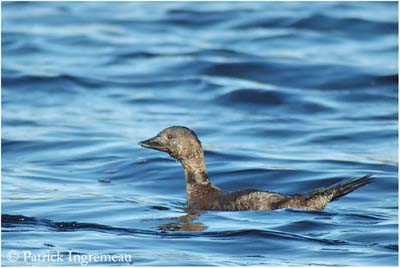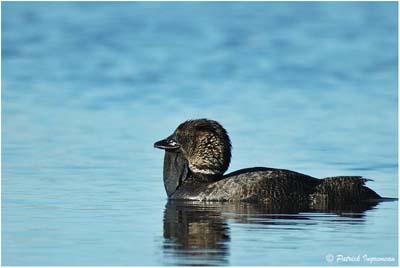
Musk Duck
Biziura lobata
Anseriforme Order – Anatidae Family
BIOMETRICS:
Length: 61-73 cm; Weight: M: 1800-3100 g; F: 990-1800 g
LONGEVITY : 20 years and more
DESCRIPTION:
Musk Duck is an endemic Australian bird species and the largest of Australian ducks. Male is larger than female. Its name comes from the strong musk odour produced by a gland on the rump.

BEHAVIOUR:
Musk Duck is a diving duck. It can dive until six metres depth. It feeds by diving into deep water, but also by dabbling. It rests on the water, but dives very often if disturbed.
As a large duck, its body floats very low over water. Usually seen single or in pairs, they may form large groups in winter.
Musk Duck is rarely seen on land. Its legs are placed far back on the body, and it is a clumsy walker.
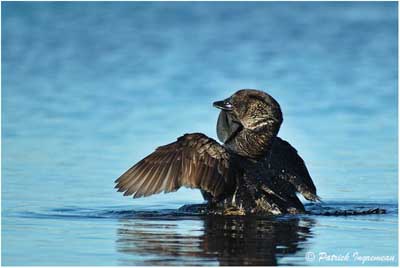
DIET:
Musk Duck feeds on aquatic insects (water beetles), water snails, frogs, crustaceans, and also a variety of aquatic vegetation, and a few fish.
This species is carnivorous, and may eat ducklings. In captivity, male is kept away from its own chicks.
PROTECTION / THREATS / STATUS:
Musk Duck may be shot by hunters sometimes, but most important threat for this species is clearing and draining of wetlands. This species is presently classified as vulnerable.
Fr: Erismature à barbillons
All : Lappenente
Esp : Malvasía de Papada
Ital : Anatra muschiata australiana
Nd : Australische Lobeend
Russe : Лопастная утка
Photographs by Patrick Ingremeau
TAMANDUA
Texte de Nicole Bouglouan
Sources :
HANDBOOK OF THE BIRDS OF THE WORLD vol 1 by Josep del Hoyo-Andrew Elliot-Jordi Sargatal - Lynx Edicions - ISBN: 8487334105
GUIDE DES CANARDS, DES OIES ET DES CYGNES – de Steve Madge - Delachaux et Niestlé - ISBN: 2603013769
Wikipedia (Wikipedia, The Free Encyclopedia)
Arthur Grosset's Birds (Arthur Grosset)
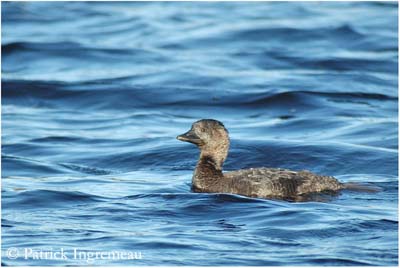
Female has similar plumage, but she is smaller in size (47 to 60 cm). She has a much-reduced lobe under the bill.
Juvenile resembles female. In young male, lobe increases as the body. It is paler in plumage, and the bill is dull yellow-tipped in the lower mandible. It seems to reach its sexual maturity several years later.
VOICE: SOUNDS BY XENO-CANTO
Musk Duck male is very noisy during displays, uttering strong grunts and loud whistles. It also performs noises with its feet, some deep “plonk”.
It is relatively silent outside breeding season.
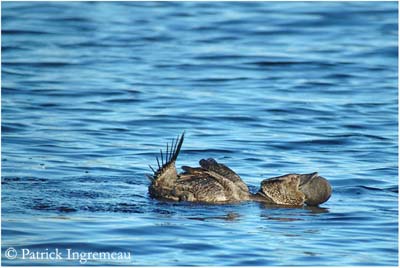
HABITAT:
Musk Duck lives in deep freshwater lagoons, with dense vegetation on shores and thick reed beds.
After breeding season, this species may be found in more open waters, such as sheltered bays or estuaries.
RANGE:
Musk Duck lives only in Australia, mainly in the South, from southern Queensland to south-west corner of Western Australia, Victoria and Tasmania.
Dispersions may occur in winter, with numerous birds flying southwards.

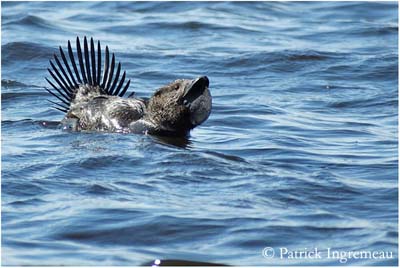
Adult male defends a territory. It is very aggressive and attacks humans or other animals if threatened. Non breeding males form small groups.
After reproduction, young ducks disperse southwards. Long distance flights are performed at night.
Musk Duck may twist and turn on the surface with an effortless agility, with feet and tail. It remains in water all day long, and only emerges for sitting on a log or on dry land for short time.
FLIGHT:
Musk Duck can fly very well, and mostly at night. It needs long distance for taking off after running over water. Landing is clumsy after long noisy glide on the surface. But Musk Duck is able to fly swiftly for long distances, performing rapid, shallow wing beats.
REPRODUCTION:
Musk Duck nests near water in vegetation, but sometimes, it may nest in a hollow in fallen tree, at water level. Several females may nest in one male’s territory, usually from July to January.
Nest is a large cup made with trampled vegetation. It is lined with fine grasses, and feathers are added after laying. It is usually well hidden in dense reeds. Female may pull reeds down from over head to form a canopy.
Female lays 2 to 3 eggs per clutch. We can find up to ten eggs in one nest, but it is the result of dump nesting. Usually, only one or two chicks survive in one clutch. Chicks are covered with dark brown down at hatching, and they are able to swim and dive within a few days.
Young remain with their mother for several months, and can be seen sometimes on her back. She provides them the most part of their food until they are full-grown. Male doesn’t take part in nesting duties.
